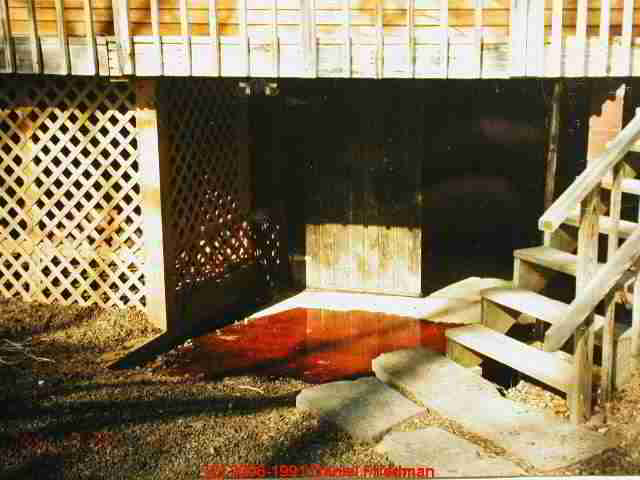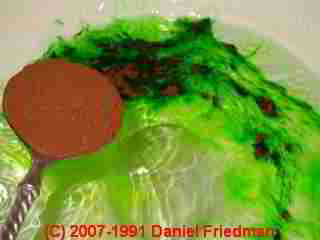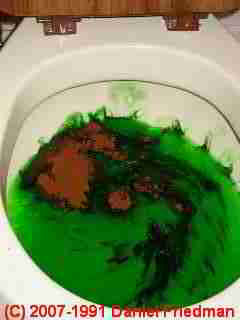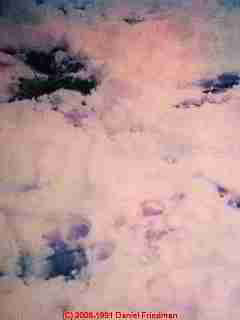 Home Buyer's Guide to Septic Dye Testing
Home Buyer's Guide to Septic Dye Testing
- POST a QUESTION or COMMENT about How to Inspect & Test Septic Systems When Buying A Home
Septic Loading and Dye Test Procedure for home buyers.
This document provides advice for home buyers who are buying a property with a private septic system, that is, a septic tank and a leach field or drainfield or similar soil absorption system.
This page answers: what is a septic dye test, how should it be performed, what are its use and its limitations?
Questions to ask about the septic system, how to perform the visual septic inspection, ordering the loading and septic dye test (the too-obvious results of a dye test at a problem site are in the photo ), pumping the septic tank, and finding additional information about the septic system. We explain how to be sure your septic inspection and septic test are conducted properly.
We tell you where to get more septic system information about a given property, and we warn of unsanitary or dangerous site conditions.
InspectAPedia tolerates no conflicts of interest. We have no relationship with advertisers, products, or services discussed at this website.
- Daniel Friedman, Publisher/Editor/Author - See WHO ARE WE?
5-3. LOADING & DYE TEST How to Perform a Home Buyer's Septic Loading & Dye Test
Pre Purchase Septic Testing (A good idea, essential in some circumstances.) Most home sales are contingent upon a home Inspection. But home inspections do not usually include a test of the existing septic system.
Septic Tests are beyond the scope of a professional home inspection but these septic tests are offered as an additional for-fee service by many home inspectors who serve areas where private systems are common.
The photo at above left shows septic dye being measured into a toilet to begin a septic loading and dye test.
Hire your own septic test consultant who has experience with and is familiar with septic loading and dye testing standards, a licensed septic inspector (in states which license this specialty such as MA), or a licensed septic system installer, who performs a great deal of work in the particular town.
They can give you advice as to the condition of the soils and septic systems In the area and what might be expected (especially pertaining to costs) if/when you find problems with the existing system.
This photo shows a small property bordering on a river. We were told that a "new septic system" was installed but I could not see where a conventional tank and drainfield could possibly fit except below the driveway.
Because of the nearly overwhelming temptation at such sites to pipe septic effluent directly into the river, we performed a septic loading and dye test to see if the river would turn red.
The river did not quickly turn red but after less than 100 gallons of water had been run into the septic system our red septic dye appeared at the basement entry platform at the edge of the driveway, as shown in the photo used at the top of this page.
A septic loading and dye test is essential if nothing is known about the septic system, if the system is more than 4 years old, if there is already evidence of a problem such as odors, soggy areas, or a history of frequent pumping.
Your consultant should tell you his or her level of concern and can tell you if the loading/dye test seems like a good idea or an unnecessary expense. If there is no indication of a septic system problem, and if the system is just a few years old, and if the system has received proper maintenance, the risk level is less and you may elect to skip this test.
Warning: even a "new" system may be defective and can fail this test. The photograph shows septic dye being flushed down the toilet to begin the test. Water must be run at fixtures which drain into the septic system to continue this procedure.
Warning:: Unfortunately many of the people performing these tests perform only a perfunctory test such as a low-water volume test (50 gallons is meaningless) or use an insufficient amount of tracer septic dye.
Therefore, the conclusions reached from these tests are often misleading. Be sure your test is performed by an expert and that an adequate volume of water is used. We specify no less than 50 gallons per bedroom or 250 gallons, whichever is greater.
Warning: if you hire a separate consultant only to perform the septic inspection and dye test you're at risk of getting a bad deal. It takes time to get enough water into the system to perform a reasonably aggressive test. It's economical to do this test when it is overlapped with other work at the site (like a home inspection).
But someone coming to the site just to do the septic test is not going to wait around for 2+ hours for water to run into the system - you're likely to get an inadequate test. If you must use a third party just for this test be sure to review the test parameters and agree on them ahead of time.
Warning: Do not pump the septic tank before the loading and dye test. Depending on its size an empty septic tank could require 2-3 days' worth of water to re-fill the tank. An empty tank means that the "loading water" run into the system during the dye test procedure is simply filling the tank rather than testing the ability of the drain field to absorb effluent.
5-3a WHAT'S A DYE TEST? What is a Septic Dye Test?
This procedure puts a test volume of water into the system to look for evidence of a blocked pipe or for breakout of septic effluent at the yard surface - indications of the need for repair. If you are looking at a completely new home and septic system you might omit this test but don't assume that new systems are immune to failures.
Pipes settle and break or systems can be improperly installed. If the tank was pumped immediately before your inspection you should be suspicious, and you might defer the loading and dye test as it may be unable to put enough water into the system to test the drain fields. The dye itself is just a coloring agent to identify water that may appear at the yard surface. It's the test volume of water that's important.

If the septic dye appears on the ground or appears in a brook or catch basin the septic system is in failure. Further investigation will be needed to determine the extent of septic repairs needed, though an informed inspector can often make a reasonable guess about what will be needed: a complete septic field replacement or more limited repairs.
The common septic testing dyes used are green or red depending on the environment. We have seen dye breakout in as little as 15-30 minutes in many instances where there was no pre-existing wet spot but where subsequent excavation confirmed that the system was either damaged or in failure. In unusual cases septic dye may appear at nearby waterways as much as five days after the test has been performed.
The first or left-hand photograph shows green septic dye appearing on a leafy yard surface near the drainfield during a septic loading and dye test. The second photo shows red septic dye appearing up through a modest snow cover during a winter test of a septic system using septic dye. Use of florescent dyes permits detection of even very dilute concentrations of dye, but usually the color and sheen of the dye are unmistakable without requiring UV lighting.
See SEPTIC LOADING & DYE TEST PROCEDURE, for complete details of the septic loading and dye test procedure, test data forms, septic loading test water volumes, septic tracer dye quantities, critical observations.
5-3b TEST LIMITATIONS Septic Dye Test Limitations
Warning: if dyed effluent or water does not break out on the property surface, this does not necessarily mean the system is functioning or will function properly in the future.
There are certainly cases in which effluent does not appear at the surface for some time, possibly up to five days, and there are other defects which predict upcoming expensive repair or replacement of the system but which are not detected by loading the drain field.
National data collected among professional home inspectors between 1985 and 1995 indicated that a significant number of inspectors performing dye tests discovered total failure of the septic system within 20 to 30 minutes of beginning testing.
We agree that a dye test is by no means a complete test of a system, that the other measures suggested here are extremely valuable, and that the volume of water used is critical: too little or too much can both be serious mistakes.
If a wet area or soggy area is present, dye has been found to appear in the short time indicated. However beware: NYS DEC has found dye appearing in nearby streams as late as five days following a septic dye test in cases where effluent migrates through considerable ground area before entering a stream.
5-3c FLOODING TESTS What Are Septic "Flooding Tests"?

Some authors describe an attempt to "FLOOD" THE SEPTIC SYSTEM WITH 1000 GALLONS OF WATER TO ATTEMPT to force a sign of system failure to manifest itself. A typical home with a private well and pressure tank should be able to deliver 5 gallons per minute.
If this test were performed overlapped with a home inspection (a 2 1/2 to 4 hour procedure) one could obtain this test volume.
Warning this test should not normally be attempted. Placing 1000 gallons of water into a septic system in two hours is likely to exceed its design parameters, and in the case of certain systems, it could actually damage the system.
While all inspections and tests should aggressively seek to protect the interests of the parties involved by being thorough, a test which exceeds system design parameters would be improper.
5-3d PROBE TESTS of Septic Fields & Locating Septic Components
Probing is a procedure whereby the Inspector attempts to locate the "KEY" ELEMENTS OF THE SYSTEM (SEPTIC TANKS AND LEACH FIELDS) and determine if they are experiencing hydraulic distress (meaning the septic tank and fields are flooded).
If a probe in a leach field produces a hole which fills rapidly with water this test indeed indicates a problem with the system.
But if a probe does not produce this condition, the test has been unreliable since it may be during a time of dry soils or a day when very little water was used by the homeowner or the home in fact may have been vacant.
This test, if performed, must be done by an expert, with caution, and is inconclusive if it does not detect a problem.
The photo here is not really a probe test, rather our septic pumping contractor is exploring the condition of the septic tank after it has already been located.
WARNING: probing can damage buried equipment such as fiberglass septic tanks or tank covers or plastic septic drain lines. Further, there is little assurance that the probing is done in the area where a problem is present.
...
Continue reading at SEPTIC TEST FINAL OVERVIEW or select a topic from the closely-related articles below, or see the complete ARTICLE INDEX.
Or see these
Recommended Articles
- SEPTIC SYSTEM TEST BASICS - quick guide for buying a home with a septic tank
- HOME BUYERS GUIDE to SEPTIC SYSTEMS - complete guide to buying a home with a septic tank
- SEPTIC SYSTEM TROUBLE: WHAT GOES WRONG
- HOME BUYER'S SEPTIC TEST
- PRE-PURCHASE SEPTIC DYE TEST
- SEPTIC TEST FINAL OVERVIEW
- SEPTIC DYE SOURCES, SAFETY, TOXICITY, STAINING, MSDS
- SEPTIC FAILURE LAWSUIT
- HOME SELLERS GUIDE TO SEPTIC INSPECTION
Suggested citation for this web page
PRE-PURCHASE SEPTIC DYE TEST at InspectApedia.com - online encyclopedia of building & environmental inspection, testing, diagnosis, repair, & problem prevention advice.
Or see this
INDEX to RELATED ARTICLES: ARTICLE INDEX to SEPTIC SYSTEMS
Or use the SEARCH BOX found below to Ask a Question or Search InspectApedia
Ask a Question or Search InspectApedia
Try the search box just below, or if you prefer, post a question or comment in the Comments box below and we will respond promptly.
Search the InspectApedia website
Note: appearance of your Comment below may be delayed: if your comment contains an image, photograph, web link, or text that looks to the software as if it might be a web link, your posting will appear after it has been approved by a moderator. Apologies for the delay.
Only one image can be added per comment but you can post as many comments, and therefore images, as you like.
You will not receive a notification when a response to your question has been posted.
Please bookmark this page to make it easy for you to check back for our response.
IF above you see "Comment Form is loading comments..." then COMMENT BOX - countable.ca / bawkbox.com IS NOT WORKING.
In any case you are welcome to send an email directly to us at InspectApedia.com at editor@inspectApedia.com
We'll reply to you directly. Please help us help you by noting, in your email, the URL of the InspectApedia page where you wanted to comment.
Citations & References
In addition to any citations in the article above, a full list is available on request.
- New York State Department of Health, APPENDIX 75-A WASTEWATER TREATMENT STANDARDS - INDIVIDUAL HOUSEHOLD SYSTEMS , [PDF] New York State Department of Health, 3 February 2010, retrieved 3/1/2010, original source: https://www.health.ny.gov/regulations/nycrr/title_10/part_75/appendix_75-a.htm
- Portions of the original text were provided by the CT Department of Public Health and Addiction Services. Daniel Friedman (web author) has made extensive edits and content additions to the original file.
- In addition to citations & references found in this article, see the research citations given at the end of the related articles found at our suggested
CONTINUE READING or RECOMMENDED ARTICLES.
- Carson, Dunlop & Associates Ltd., 120 Carlton Street Suite 407, Toronto ON M5A 4K2. Tel: (416) 964-9415 1-800-268-7070 Email: info@carsondunlop.com. Alan Carson is a past president of ASHI, the American Society of Home Inspectors.
Thanks to Alan Carson and Bob Dunlop, for permission for InspectAPedia to use text excerpts from The HOME REFERENCE BOOK - the Encyclopedia of Homes and to use illustrations from The ILLUSTRATED HOME .
Carson Dunlop Associates provides extensive home inspection education and report writing material. In gratitude we provide links to tsome Carson Dunlop Associates products and services.





